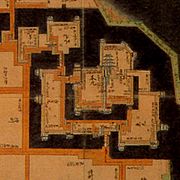Funai Castle
| Funai Castle | ||
|---|---|---|
|
Funai Castle |
||
| Castle type : | Hirajiro ( Lower Castle ) | |
| Conservation status: | Walls preserved | |
| Place: | Ōita | |
| Geographical location | 33 ° 14 '26.3 " N , 131 ° 36' 41.2" E | |
|
|
||
The Castle Funai ( Japanese 府内城 , Funai-jō ) is located in the city of Oita ( prefecture Oita ).
history
According to tradition, after the Ōtomo had been deposed, Hayakawa Nagatoshi ( 早川 長 敏 ) received the castle. Later she came to Fukuhara Naotaka ( 福 原 直 高 ). Fukuhara gave up the house of the Ōtomo ( 大 友 館 , Ōtomo-date ) and built a castle at the mouth of the Kawahara River, where it is still located today. The burger maker Fukuhara was also banned, and Hayakawa was able to take over the castle again. But then he belonged to the losing side in the Battle of Sekigahara and took his own life.
1601 Takenaka Shigetoshi ( 竹 中 重利 ; 1562-1615) was enfeoffed with the castle and an income of 20,000 koku . Until 1611 he repaired the castle, which now also included a castle tower. In 1634 the castle fell to Hineno Yoshiaki ( 日 根 野 吉明 ; 1587–1656) with also 20,000 koku. From 1658 Matsudaira Tadaaki ( 松 平 忠 昭 ; 1617–1693) from a branch of the Ōgyū-Matsudaira lord of the castle with 22,000 koku. His descendants resided there until 1868.
The north side of the castle used to border Ōita Bay with its innermost complex, the Hommaru. The Hommaru was protected by the other castle areas Ni-no-maru and Yamazato-no-maru. The Ni-no-maru was divided into two areas by a moat into a western area ( Nishi-no-maru ) and an eastern area ( Higashi-no-maru ). Hommaru and Ninomaru were protected by stone walls and a four-story castle tower (tenshukaku) when viewed from the outside. The base of the castle tower consists of irregular stone blocks ( 野 面積 , nozura-zumi ), the corners are designed as sangi-zumi ( 算 木 積 ), i.e. with neatly hewn corner stones.
In addition to the castle tower, the castle was protected by a number of other towers ( 櫓 , yagura ). Most of the buildings were lost in a fire in 1743. The Shūmon-yagura ( 宗 門 櫓 ) and the Hitojichi-yagura ( 人質 櫓 ) are preserved; the Tōchaku-yagura ( 到 着 櫓 ) and the Ōte-mon ( 大 手 門 ) are reconstructions.
Imagery
literature
- Yamanouchi: Funai-jo in: Miura, Masayuki (Ed.): Shiro to jinya Saiokoku-hen . Gakken, 2006, ISBN 978-4-05-604378-5 , pp. 68-69.
- Okayama-ken no rekishisampo henshukai (Ed.): Ōita-ken no rekishi sampo . Yamakawa Shuppan, 2009, ISBN 978-4-634-24633-1 .




